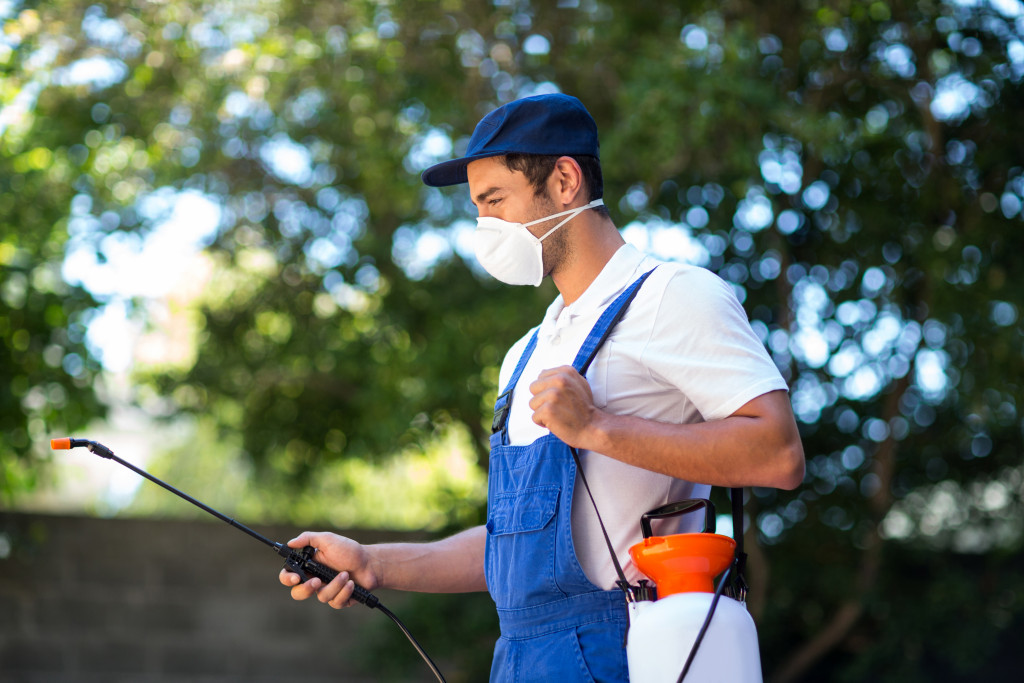Applying pesticides is sometimes necessary, especially when the health of plants and crops are in the line. There are many kinds of pesticides to choose from in the market, but the most common type is the liquid formulation.
You need to know about handling pesticides to gain more insight into what to prepare and how to clean up after. Here are some general rules to keep in mind before you get started.
Know Your Stuff
Before handling and administering the pesticides, it’s essential to familiarize yourself with your chosen pesticide’s precautions and instructions. Knowing how to mix and apply it to your plants or crops is not only going to make it more effective, but it’ll also be safer for you—handling it as advised is crucial to your safety and your health.
Have the Right Tools
A sprayer is the most commonly used tool to deliver pesticides. Its mechanism uses a combination of water and air to distribute pesticides in a targeted manner. From a few gallons to a thousand, sprayers have a wide range of sizes. For smaller areas and spot treatments, backpack sprayers are used. Meanwhile, there are sprayers so heavy that they need to be pulled behind tractors for bigger areas.
There are different kinds of nozzles: brass, stainless steel, aluminum, plastic, ceramic, or a combination of these. Brass, aluminum, and plastic are some materials used. Plastic, brass, and aluminum are the least expensive of these nozzles, although they tend to wear faster. But ultimately, the nozzle material you choose should be based on the pesticide products you’ll be using.
Other applicators have opted to use agricultural drones for this task. They aren’t just a safer alternative; they’re efficient, too. Many drones today are manufactured to perform tasks such as this, making them faster and more precise.
Wear the Right Gear
Speaking of things to use, there are also things to wear. Personal protective equipment or PPE is protective clothing and equipment such as safety goggles, rubber gloves, masks, and hazmat suits. These are usually worn when dealing with potentially harmful substances. In this case, it’s pesticides. Be sure to cover as much skin as you can. Opt for long-sleeved tops, pants, boots, and wear socks too.
Prepare Your First Aid Kit and Station
In case of an emergency, keep your first aid with you or close to you when applying pesticide. Because this is a very particular setting, it’s best to prepare a separate first aid kit that caters to pesticide poisoning and other related injuries. Moreover, having a pesticide first aid station is also ideal, especially for fatal emergencies. A station should include an eyewash bottle, a clean change of clothes, clean water, liquid detergent, activated charcoal powder, and disposable towels.

Clean Tools and Equipment
Once the job is completed, you should clean up and put everything away properly. Don’t be too complacent even after the pesticide is applied, as residues may get on your equipment. No matter how little the residue, it can still potentially cause harm. Before putting away all the tools and equipment used, be sure to give them a thorough cleaning. These include gloves, boots, buckets, towels, and more. Even if you wear your clothes with a hazmat over them, you should still wash them with the same amount of thoroughness. Be sure to wash these clothes separately from other clothes in the hamper.
Store Them Properly
It’s a rule of thumb to keep abrasive and toxic solutions in a separate, cool, well-ventilated place. Pesticides are no exception to this. The chemicals may react to extreme temperature changes or direct exposure to sunlight.
Another rule for toxic solutions such as pesticides is to keep these out of reach of kids and pets for obvious reasons. Additionally, avoid transferring pesticides to other containers like soft drink bottles. This could be a dangerous accident waiting to happen. Although these are generally the recommended measures in storing pesticides, be sure to read the storage instructions on the label. Speaking of labels, keep the product labels in legible condition as much as possible.
Dispose of Waste Safely
Speaking of following instructions on the product label, it’s also essential to follow the manufacturer’s recommendations for disposal. Before throwing empty containers away, be sure to clean them thoroughly and multiple times. You can also ask your local government or read up on guidelines for proper disposal procedures.
Final Thoughts
A responsible gardener or farmer knows the responsibility that’s involved when using pesticides. Not just for its use, but in storage and preparation too. When dealing with potentially dangerous materials, it’s always essential to be mentally present and remain alert in case of an emergency.





